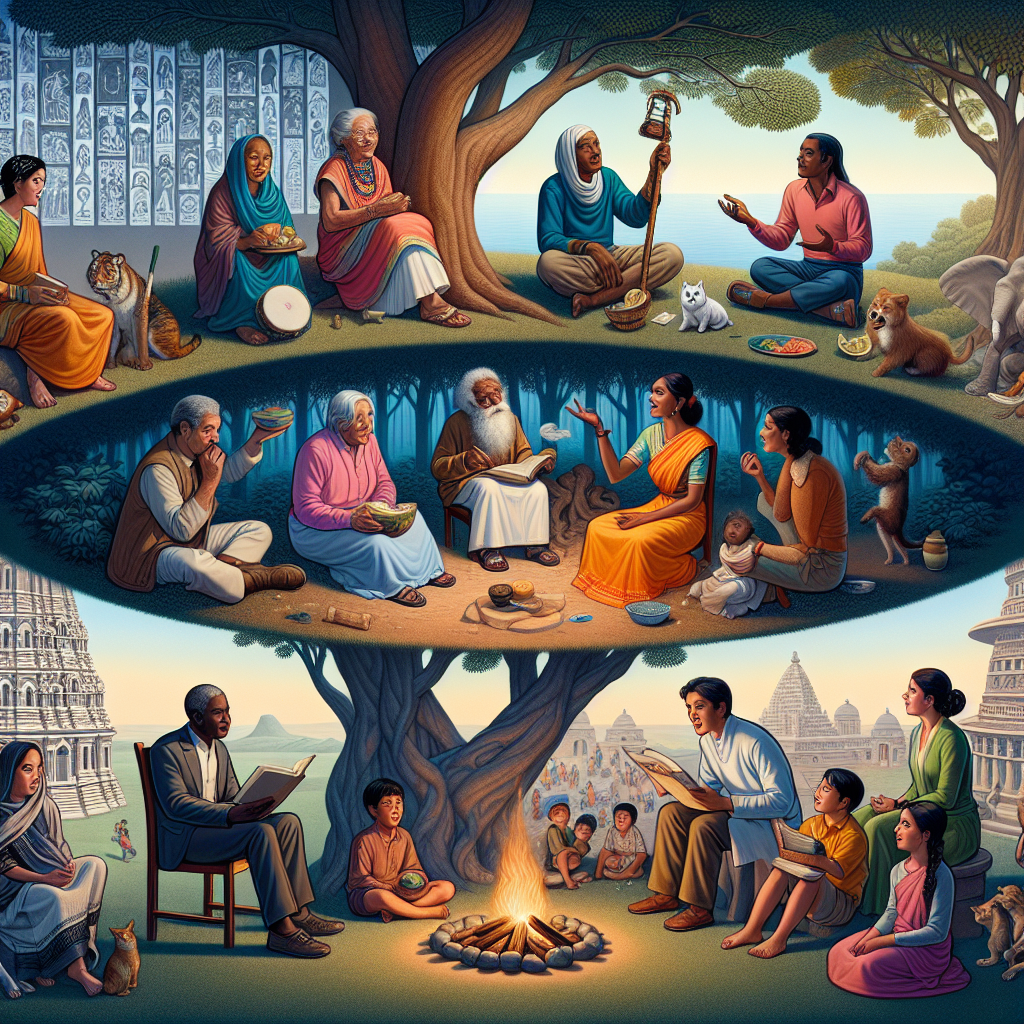Oral Traditions: The Power Of Storytelling Across Cultures
Immerse yourself in the enchanting world of oral traditions as we explore the captivating power of storytelling across cultures. From ancient myths that have been passed down through generations to modern tales that inspire and entertain, these oral traditions offer a unique glimpse into the cultural fabric of different societies. Discover how stories have the ability to transcend time and borders, connecting us to our shared humanity and providing a window into the diverse experiences and perspectives that make our world so beautifully varied. Join us as we embark on a journey through the rich tapestry of oral traditions, inviting you to listen, learn, and be inspired.
Understanding Oral Traditions
Definition of Oral Traditions
Oral traditions refer to the cultural practices and customs passed down from generation to generation through spoken words, songs, chants, and narratives rather than through written records. This form of cultural transmission is prevalent in many societies around the world and plays a crucial role in preserving history, values, beliefs, and knowledge within communities.
Oral vs Written Traditions
While written traditions rely on written texts, documents, and books to convey information, oral traditions primarily rely on spoken words and the collective memory of individuals. Unlike written traditions, oral traditions emphasize the use of verbal communication and often involve a performative aspect, such as storytelling, singing, and reciting. This oral mode of transmission allows for flexibility, adaptability, and the incorporation of personal experiences, emotions, and cultural nuances.
Significance in Different Cultures
Oral traditions hold immense significance in different cultures worldwide. They serve as a means of preserving and transmitting cultural identity, history, and values among communities. In many Indigenous cultures, oral traditions are the primary medium through which ancestral knowledge, creation stories, and the collective wisdom of the community are shared. It reinforces cultural bonds, shapes social values, and fosters a sense of belonging and continuity among community members.
The Universality of Storytelling
Connective Power of Storytelling
Storytelling is a universal human practice that transcends cultural boundaries. It has the power to forge connections and foster empathy by enabling individuals to understand and relate to experiences that may be unfamiliar to them. Regardless of language or cultural context, storytelling has the ability to evoke emotions, ignite imagination, and create shared experiences that bring people closer together.
How Stories Shape Human Experience
Stories play a fundamental role in shaping human experience by providing individuals with a framework to make sense of the world around them. They serve as a medium for transmitting cultural values, traditions, and wisdom from one generation to the next. Stories often embody moral lessons, teach important life skills, and offer guidance in navigating complex social dynamics. They can also challenge existing belief systems, provoke critical thinking, and inspire personal growth and transformation.
Universality versus Individuality in Stories
While storytelling exhibits universal themes and patterns, it is also deeply influenced by the cultural context in which it arises. Different cultures have their own unique narratives, symbols, and mythologies that reflect their history, beliefs, and worldview. While some stories may have common elements, such as hero’s journeys or creation myths, others may be specific to a particular culture or locality. This balance between universality and individuality allows for the celebration of both our shared humanity and the diversity of human experiences.
Storytelling in Indigenous Cultures
Native American Oral Traditions
Native American oral traditions are rich in storytelling, with narratives passed down through generations to preserve cultural heritage and ancestral knowledge. These traditions encompass a wide range of themes, from creation stories and legends to accounts of historical events and personal experiences. Storytelling plays a vital role in maintaining the vitality and resilience of Native American cultures, reinforcing identity, and nurturing a deep connection with the natural world.
Indigenous Australian Storytelling
Indigenous Australian storytelling is deeply rooted in the oral tradition, with Dreamtime stories serving as a significant aspect of cultural preservation. Dreamtime stories revolve around the creation of the world, the relationships between ancestral beings, and the connection between humans and the land. These narratives not only provide guidance on survival and kinship but also serve as a form of spiritual and philosophical expression.
African Tribal Narratives
African tribal narratives encompass a diverse range of storytelling traditions, reflecting the rich cultural and linguistic diversity found across the continent. Griots, the traditional storytellers of West Africa, play a pivotal role in preserving and transmitting oral history, genealogy, and moral teachings. These narratives often incorporate music, dance, and community participation, creating an immersive and interactive experience for listeners.
Asian Storytelling Traditions
Chinese Fable and Folk Tales
Chinese storytelling traditions encompass a vast collection of fables and folk tales that have been passed down for centuries. These stories often feature anthropomorphic animals, mythical creatures, and moral lessons. From the classic tales of the Monkey King in “Journey to the West” to the stories of filial piety in “The Twenty-Four Filial Exemplars,” Chinese storytelling embraces a diverse range of themes and styles.
Japanese Kamishibai
Kamishibai, a traditional form of Japanese storytelling, involves the use of illustrated boards to accompany oral narration. This storytelling technique originated in the 12th century and has evolved to include a variety of themes ranging from historical events and folktales to contemporary stories. Kamishibai performances combine visual and auditory elements, captivating audiences of all ages and fostering a deep appreciation for Japanese culture.
Indian Panchatantra
The Panchatantra, a collection of animal fables, has been a cornerstone of Indian storytelling for centuries. These tales, attributed to the ancient sage Vishnu Sharma, impart moral lessons and wisdom through the adventures and interactions of anthropomorphic animals. Panchatantra stories continue to captivate audiences and serve as a source of entertainment, education, and cultural transmission.
Storytelling in Middle Eastern Cultures
Arabian Nights and Middle Eastern Poetry
The Arabian Nights, also known as One Thousand and One Nights, holds a prominent place in Middle Eastern storytelling. This collection of tales, including iconic stories like Aladdin and Ali Baba, has captured the imaginations of readers worldwide. Middle Eastern poetry, with its lyrical and descriptive style, is also a significant form of storytelling that explores themes of love, spirituality, and social commentary.
Persian Shahnameh
The Shahnameh, an epic poem by the Persian poet Ferdowsi, recounts the mythical and historical past of Iran. This enduring masterpiece weaves together tales of heroes, kings, and ancient Persian legends, preserving the cultural heritage and national identity of the Iranian people. The Shahnameh stands as a testament to the power of storytelling in shaping collective memory and inspiring pride in one’s cultural heritage.
African Storytelling
West African Griots
Griots, often referred to as “praise singers” or “oral historians,” are the keepers of West African oral traditions. These talented storytellers recount the history, genealogy, and cultural traditions of their communities through music, poetry, and spoken word. Griots play a pivotal role in preserving the cultural fabric of West Africa, passing on invaluable knowledge and wisdom from one generation to the next.
South African Folklores
South African storytelling traditions encompass a rich tapestry of myths, legends, and folklore. These narratives draw on the diverse cultural backgrounds of the country’s inhabitants, including Zulu, Xhosa, Sotho, and many others. South African folklores often explore themes of creation, ancestry, and the relationship between humanity and nature, forging a deep connection between individuals and their cultural heritage.
Storytelling in European Cultures
Classical Greek and Roman Myths
Classical Greek and Roman myths have had a profound influence on Western storytelling traditions. These ancient stories, featuring gods, heroes, and epic quests, have shaped the literary and artistic canon of Europe. From the epic poetry of Homer’s “The Iliad” and “The Odyssey” to Ovid’s “Metamorphoses,” these tales continue to inspire and captivate audiences today.
Nordic Sagas
Nordic sagas, rooted in Norse mythology, are a prominent aspect of storytelling in Scandinavian cultures. These narratives recount the exploits of legendary gods, such as Odin and Thor, as well as mortal heroes like Beowulf. Nordic sagas are characterized by their poetic language, heroic deeds, and themes of bravery, honor, and fate.
Celtic Folklore
Celtic folklore refers to the rich oral traditions of the Celtic peoples, spanning regions such as Ireland, Scotland, Wales, and Brittany. These tales often feature mythical creatures, such as fairies and selkies, and explore the deep connection between humans and the natural world. Celtic storytelling traditions continue to thrive, with festivals and gatherings celebrating the oral heritage of these unique cultures.
Oral Traditions in Modern Times
Adapting Oral Traditions to Modern Contexts
In an era of technological advancement and globalization, oral traditions have adapted to modern contexts while retaining their essence. Storytellers are embracing new mediums, such as podcasts, digital platforms, and live performances, to reach wider audiences and ensure the survival of oral traditions. The incorporation of visual elements, music, and interactive components enhances the storytelling experience and engages contemporary audiences.
Digital Storytelling
The rise of digital storytelling has provided a platform for the preservation and dissemination of oral traditions. Websites, social media platforms, and online archives allow storytellers to share their narratives with a global audience, transcending geographical boundaries and language barriers. Digital storytelling also enables the documentation and preservation of endangered and marginalized oral traditions, ensuring their legacy for future generations.
Preserving Oral Traditions Today
Efforts are being made worldwide to preserve and safeguard oral traditions from the threats of globalization, cultural assimilation, and technology-driven societies. Organizations, universities, and communities are investing in the documentation, archiving, and revitalization of endangered oral traditions. Collaborative projects, oral history initiatives, and cultural festivals provide platforms for communities to share, celebrate, and record their unique storytelling traditions.
Oral Traditions and Cultural Preservation
Importance of Preserving Oral Traditions
Preserving oral traditions is vital for safeguarding cultural heritage, fostering intergenerational bonds, and promoting cultural diversity. Oral traditions serve as vital repositories of local knowledge, historical events, and traditional practices that may not be documented in written records. They also reinforce cultural identity, promote cultural resilience, and contribute to a sense of belonging and pride within communities.
Techniques for Preserving Oral Traditions
Various techniques and approaches are employed to preserve oral traditions in an ever-changing world. These include audio and video recordings, transcription and translation of oral narratives, community-based initiatives, and intergenerational mentorship programs. By combining modern technology with traditional practices, these preservation efforts strive to ensure the continuity and accessibility of oral traditions for future generations.
Traveling through Storytelling
Experiencing Culture through Stories
Storytelling provides a unique lens through which travelers can immerse themselves in the culture and history of the places they visit. By engaging with local storytellers and listening to their narratives, travelers gain insights into the values, traditions, and worldview of the community. Storytelling creates a bridge between visitors and locals, allowing for a deeper appreciation and understanding of different cultures.
How Storytelling Enhances Travel Experiences
Storytelling enhances travel experiences by providing a more profound connection to the destinations explored. It adds depth and context to historical sites, monuments, and landmarks, breathing life into them through the narratives associated with them. When travelers engage with local storytellers, they not only learn about the history but also gain a personal perspective on the community’s customs, folklore, and unique way of life.
Cultural Tourism and Storytelling
Storytelling plays a significant role in cultural tourism, attracting travelers who seek authentic and immersive experiences. Cultural festivals, guided storytelling tours, and interactive workshops allow visitors to engage with storytellers and participate in the preservation of oral traditions. By supporting local communities and their storytelling traditions, cultural tourism contributes to the sustainability and revitalization of these ancient practices.
In conclusion, oral traditions and storytelling are universal human practices that transcend cultural boundaries. They preserve history, transmit knowledge, shape human experiences, and foster connections among individuals and communities. From Native American oral traditions to European folklore, storytelling traditions around the world reflect the rich tapestry of human culture. In modern times, oral traditions are adapting to new mediums, such as digital platforms, while still retaining their essence. Efforts are being made to preserve oral traditions through documentation, archiving, and revitalization initiatives. Travelers can enhance their cultural experiences by engaging with local storytellers and immersing themselves in the narratives that shape different cultures. By valuing and understanding these diverse storytelling traditions, we can celebrate our shared humanity and foster appreciation for the richness and vibrancy of global cultural heritage.







